Dongdong Chen
ReasonGen-R1: CoT for Autoregressive Image generation models through SFT and RL
May 30, 2025Abstract:Although chain-of-thought reasoning and reinforcement learning (RL) have driven breakthroughs in NLP, their integration into generative vision models remains underexplored. We introduce ReasonGen-R1, a two-stage framework that first imbues an autoregressive image generator with explicit text-based "thinking" skills via supervised fine-tuning on a newly generated reasoning dataset of written rationales, and then refines its outputs using Group Relative Policy Optimization. To enable the model to reason through text before generating images, We automatically generate and release a corpus of model crafted rationales paired with visual prompts, enabling controlled planning of object layouts, styles, and scene compositions. Our GRPO algorithm uses reward signals from a pretrained vision language model to assess overall visual quality, optimizing the policy in each update. Evaluations on GenEval, DPG, and the T2I benchmark demonstrate that ReasonGen-R1 consistently outperforms strong baselines and prior state-of-the-art models. More: aka.ms/reasongen.
DeepInverse: A Python package for solving imaging inverse problems with deep learning
May 26, 2025Abstract:DeepInverse is an open-source PyTorch-based library for solving imaging inverse problems. The library covers all crucial steps in image reconstruction from the efficient implementation of forward operators (e.g., optics, MRI, tomography), to the definition and resolution of variational problems and the design and training of advanced neural network architectures. In this paper, we describe the main functionality of the library and discuss the main design choices.
Phi-4-Mini-Reasoning: Exploring the Limits of Small Reasoning Language Models in Math
Apr 30, 2025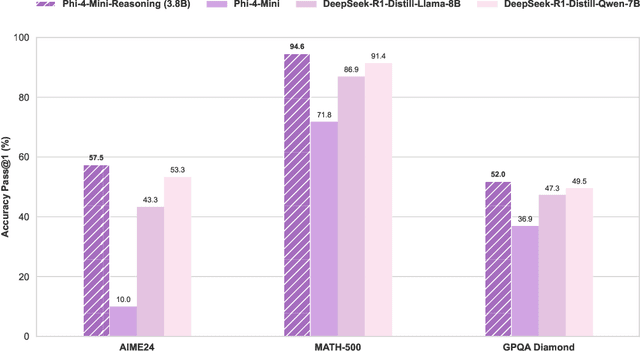


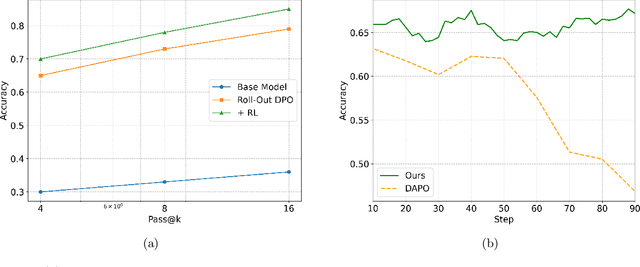
Abstract:Chain-of-Thought (CoT) significantly enhances formal reasoning capabilities in Large Language Models (LLMs) by training them to explicitly generate intermediate reasoning steps. While LLMs readily benefit from such techniques, improving reasoning in Small Language Models (SLMs) remains challenging due to their limited model capacity. Recent work by Deepseek-R1 demonstrates that distillation from LLM-generated synthetic data can substantially improve the reasoning ability of SLM. However, the detailed modeling recipe is not disclosed. In this work, we present a systematic training recipe for SLMs that consists of four steps: (1) large-scale mid-training on diverse distilled long-CoT data, (2) supervised fine-tuning on high-quality long-CoT data, (3) Rollout DPO leveraging a carefully curated preference dataset, and (4) Reinforcement Learning (RL) with Verifiable Reward. We apply our method on Phi-4-Mini, a compact 3.8B-parameter model. The resulting Phi-4-Mini-Reasoning model exceeds, on math reasoning tasks, much larger reasoning models, e.g., outperforming DeepSeek-R1-Distill-Qwen-7B by 3.2 points and DeepSeek-R1-Distill-Llama-8B by 7.7 points on Math-500. Our results validate that a carefully designed training recipe, with large-scale high-quality CoT data, is effective to unlock strong reasoning capabilities even in resource-constrained small models.
Show and Segment: Universal Medical Image Segmentation via In-Context Learning
Mar 25, 2025Abstract:Medical image segmentation remains challenging due to the vast diversity of anatomical structures, imaging modalities, and segmentation tasks. While deep learning has made significant advances, current approaches struggle to generalize as they require task-specific training or fine-tuning on unseen classes. We present Iris, a novel In-context Reference Image guided Segmentation framework that enables flexible adaptation to novel tasks through the use of reference examples without fine-tuning. At its core, Iris features a lightweight context task encoding module that distills task-specific information from reference context image-label pairs. This rich context embedding information is used to guide the segmentation of target objects. By decoupling task encoding from inference, Iris supports diverse strategies from one-shot inference and context example ensemble to object-level context example retrieval and in-context tuning. Through comprehensive evaluation across twelve datasets, we demonstrate that Iris performs strongly compared to task-specific models on in-distribution tasks. On seven held-out datasets, Iris shows superior generalization to out-of-distribution data and unseen classes. Further, Iris's task encoding module can automatically discover anatomical relationships across datasets and modalities, offering insights into medical objects without explicit anatomical supervision.
FreeFlux: Understanding and Exploiting Layer-Specific Roles in RoPE-Based MMDiT for Versatile Image Editing
Mar 20, 2025
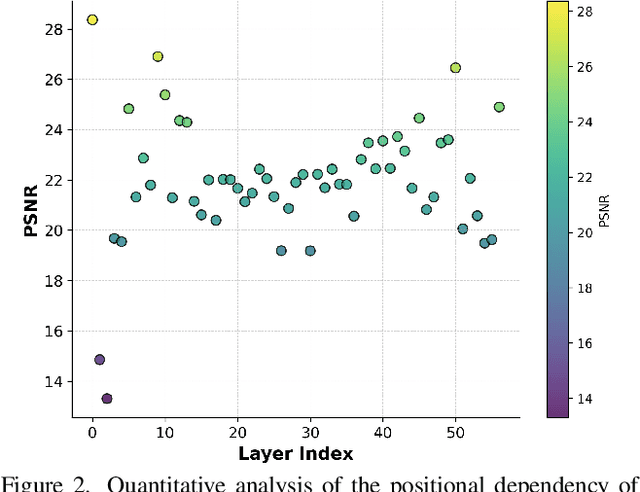
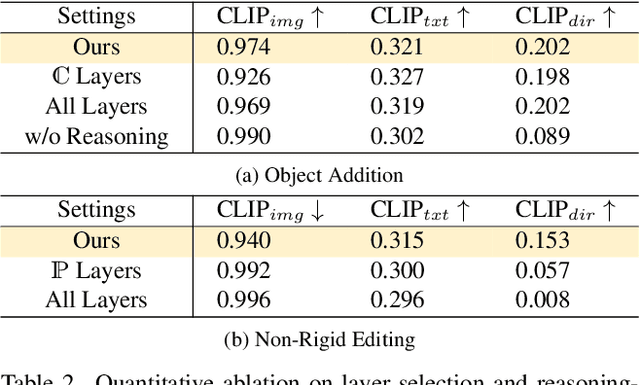
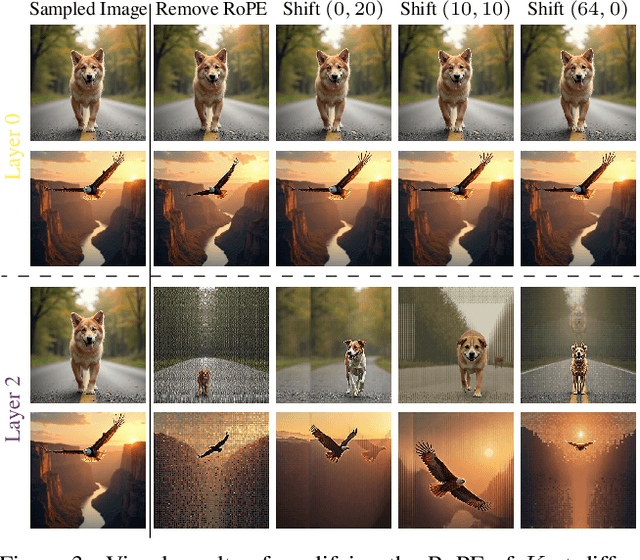
Abstract:The integration of Rotary Position Embedding (RoPE) in Multimodal Diffusion Transformer (MMDiT) has significantly enhanced text-to-image generation quality. However, the fundamental reliance of self-attention layers on positional embedding versus query-key similarity during generation remains an intriguing question. We present the first mechanistic analysis of RoPE-based MMDiT models (e.g., FLUX), introducing an automated probing strategy that disentangles positional information versus content dependencies by strategically manipulating RoPE during generation. Our analysis reveals distinct dependency patterns that do not straightforwardly correlate with depth, offering new insights into the layer-specific roles in RoPE-based MMDiT. Based on these findings, we propose a training-free, task-specific image editing framework that categorizes editing tasks into three types: position-dependent editing (e.g., object addition), content similarity-dependent editing (e.g., non-rigid editing), and region-preserved editing (e.g., background replacement). For each type, we design tailored key-value injection strategies based on the characteristics of the editing task. Extensive qualitative and quantitative evaluations demonstrate that our method outperforms state-of-the-art approaches, particularly in preserving original semantic content and achieving seamless modifications.
I2V3D: Controllable image-to-video generation with 3D guidance
Mar 12, 2025



Abstract:We present I2V3D, a novel framework for animating static images into dynamic videos with precise 3D control, leveraging the strengths of both 3D geometry guidance and advanced generative models. Our approach combines the precision of a computer graphics pipeline, enabling accurate control over elements such as camera movement, object rotation, and character animation, with the visual fidelity of generative AI to produce high-quality videos from coarsely rendered inputs. To support animations with any initial start point and extended sequences, we adopt a two-stage generation process guided by 3D geometry: 1) 3D-Guided Keyframe Generation, where a customized image diffusion model refines rendered keyframes to ensure consistency and quality, and 2) 3D-Guided Video Interpolation, a training-free approach that generates smooth, high-quality video frames between keyframes using bidirectional guidance. Experimental results highlight the effectiveness of our framework in producing controllable, high-quality animations from single input images by harmonizing 3D geometry with generative models. The code for our framework will be publicly released.
Phi-4-Mini Technical Report: Compact yet Powerful Multimodal Language Models via Mixture-of-LoRAs
Mar 03, 2025Abstract:We introduce Phi-4-Mini and Phi-4-Multimodal, compact yet highly capable language and multimodal models. Phi-4-Mini is a 3.8-billion-parameter language model trained on high-quality web and synthetic data, significantly outperforming recent open-source models of similar size and matching the performance of models twice its size on math and coding tasks requiring complex reasoning. This achievement is driven by a carefully curated synthetic data recipe emphasizing high-quality math and coding datasets. Compared to its predecessor, Phi-3.5-Mini, Phi-4-Mini features an expanded vocabulary size of 200K tokens to better support multilingual applications, as well as group query attention for more efficient long-sequence generation. Phi-4-Multimodal is a multimodal model that integrates text, vision, and speech/audio input modalities into a single model. Its novel modality extension approach leverages LoRA adapters and modality-specific routers to allow multiple inference modes combining various modalities without interference. For example, it now ranks first in the OpenASR leaderboard to date, although the LoRA component of the speech/audio modality has just 460 million parameters. Phi-4-Multimodal supports scenarios involving (vision + language), (vision + speech), and (speech/audio) inputs, outperforming larger vision-language and speech-language models on a wide range of tasks. Additionally, we experiment to further train Phi-4-Mini to enhance its reasoning capabilities. Despite its compact 3.8-billion-parameter size, this experimental version achieves reasoning performance on par with or surpassing significantly larger models, including DeepSeek-R1-Distill-Qwen-7B and DeepSeek-R1-Distill-Llama-8B.
On the Vulnerability of Concept Erasure in Diffusion Models
Feb 24, 2025



Abstract:The proliferation of text-to-image diffusion models has raised significant privacy and security concerns, particularly regarding the generation of copyrighted or harmful images. To address these issues, research on machine unlearning has developed various concept erasure methods, which aim to remove the effect of unwanted data through post-hoc training. However, we show these erasure techniques are vulnerable, where images of supposedly erased concepts can still be generated using adversarially crafted prompts. We introduce RECORD, a coordinate-descent-based algorithm that discovers prompts capable of eliciting the generation of erased content. We demonstrate that RECORD significantly beats the attack success rate of current state-of-the-art attack methods. Furthermore, our findings reveal that models subjected to concept erasure are more susceptible to adversarial attacks than previously anticipated, highlighting the urgency for more robust unlearning approaches. We open source all our code at https://github.com/LucasBeerens/RECORD
SmartEraser: Remove Anything from Images using Masked-Region Guidance
Jan 14, 2025



Abstract:Object removal has so far been dominated by the mask-and-inpaint paradigm, where the masked region is excluded from the input, leaving models relying on unmasked areas to inpaint the missing region. However, this approach lacks contextual information for the masked area, often resulting in unstable performance. In this work, we introduce SmartEraser, built with a new removing paradigm called Masked-Region Guidance. This paradigm retains the masked region in the input, using it as guidance for the removal process. It offers several distinct advantages: (a) it guides the model to accurately identify the object to be removed, preventing its regeneration in the output; (b) since the user mask often extends beyond the object itself, it aids in preserving the surrounding context in the final result. Leveraging this new paradigm, we present Syn4Removal, a large-scale object removal dataset, where instance segmentation data is used to copy and paste objects onto images as removal targets, with the original images serving as ground truths. Experimental results demonstrate that SmartEraser significantly outperforms existing methods, achieving superior performance in object removal, especially in complex scenes with intricate compositions.
Benchmarking Large and Small MLLMs
Jan 04, 2025



Abstract:Large multimodal language models (MLLMs) such as GPT-4V and GPT-4o have achieved remarkable advancements in understanding and generating multimodal content, showcasing superior quality and capabilities across diverse tasks. However, their deployment faces significant challenges, including slow inference, high computational cost, and impracticality for on-device applications. In contrast, the emergence of small MLLMs, exemplified by the LLava-series models and Phi-3-Vision, offers promising alternatives with faster inference, reduced deployment costs, and the ability to handle domain-specific scenarios. Despite their growing presence, the capability boundaries between large and small MLLMs remain underexplored. In this work, we conduct a systematic and comprehensive evaluation to benchmark both small and large MLLMs, spanning general capabilities such as object recognition, temporal reasoning, and multimodal comprehension, as well as real-world applications in domains like industry and automotive. Our evaluation reveals that small MLLMs can achieve comparable performance to large models in specific scenarios but lag significantly in complex tasks requiring deeper reasoning or nuanced understanding. Furthermore, we identify common failure cases in both small and large MLLMs, highlighting domains where even state-of-the-art models struggle. We hope our findings will guide the research community in pushing the quality boundaries of MLLMs, advancing their usability and effectiveness across diverse applications.
 Add to Chrome
Add to Chrome Add to Firefox
Add to Firefox Add to Edge
Add to Edge